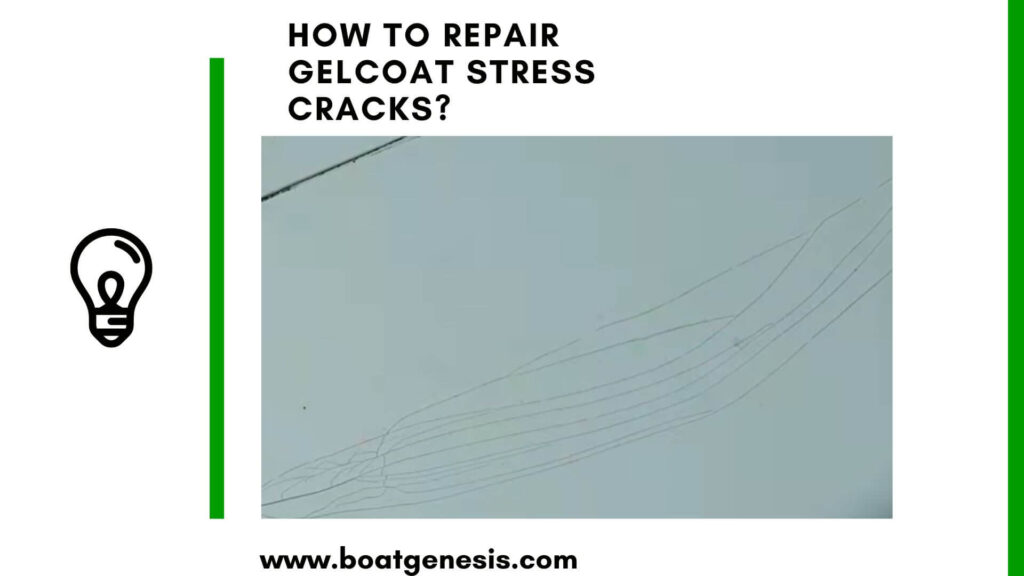You’ve noticed some odd lines across the gelcoat surface of your boat. Unlike small spiderweb patterns, these cracks tend to form straight fissures emanating from corners or hardware.
Upon closer inspection, you realize that these are stress cracks in the gelcoat – a common issue as your boat ages.
While ugly and annoying, gelcoat stress cracks don’t immediately jeopardize hull integrity if repaired promptly.
This article will cover what causes stress cracks, preparation steps, materials needed, and a simple repair procedure for DIY boating owners.
What Causes Gelcoat Stress Cracks?
The coloured and glossy gelcoat applied over fiberglass has little flexibility.
Over years of use, especially with sun exposure, normal expansion and contraction can cause the gelcoat to develop cracks under stress points. Materials and design flaws can also be contributing factors.
The website My Yacht Management says that The gel coat finish lasts for years with proper care and refinishing, enduring for decades without major repairs.
Common areas for stress cracks include:
- Corners of hatches, ports, or hardware
- Around rails, cleats or benches
- Where rollers meet the hull surface
- Near canvas snaps or hull/deck joints
If left alone, stress cracks allow water intrusion leading to more serious fiberglass repairs. Address these sooner than later before they worsen.
Prep Work: Clean and Open Cracks
Proper surface prep is key to achieving crack repairs that will last:
- Clean the hull with a bleaching cleaner to remove grime and wax
- Use a Dremel or sandpaper to open stress cracks
- Clean cracks out with acetone applied via a syringe
- Mask off repair zones with masking tape
With the hull now prepped, it’s time to apply gel coat patching material to fill cracks.
DIY Gelcoat Stress Crack Repair
For stress cracks, a thicker patching compound works better than light texture finishes. Consider more advanced repair kits for large or complex cracks.
Here’s an overview of the DIY repair process:
- Prepare gelcoat surface as described above
- Mix gelcoat patch material per instructions
- Fill all cracks thoroughly from the bottom up
- Overfill slightly with plastic spreader
- Smooth to blend with the surrounding area
- Remove masking tape just before curing
- Allow the patch to fully cure
- Sand lightly if needed to smooth
Once repairs have cured, applying an epoxy sealer and wax can help prevent the recurrence of cracks. Be sure to address design issues that may be causing excess stress in certain areas.
==>> Read my full article about repairing all types of gelcoat cracks here.
FAQs About Gelcoat Stress Cracks
Still have some lingering questions about repairing cracks in your boat’s gelcoat? Here are answers to a few frequently asked questions:
Spider cracks spread out in web-like patterns across the gelcoat surface. They may be shallow crazing from normal expansion and contraction.
-Stress cracks form straight lines emanating out from corners and hardware. These result from consistent pressure on vulnerable areas.
Exposure to the sun, extreme heat, and dramatic temperature fluctuations can all cause expansion, contraction, and eventual cracking. Colder climates still lead to cracking as the boat hull moves in and out of freezing waters.
Crack surface preparation takes 1-2 hours. Repair materials may cure overnight or for up to 3 days depending on the products selected. Additional waxing/sealing takes 1-2 hours once the patching has fully hardened.
Copper coat can temporarily cover cracks but provides no crack-filling abilities. It is not an adhesive, structural patch for crack repairs. Still, it adds a protective coating against further water damage.
If you’re very handy with tools and compounds, this can certainly be a DIY endeavor. For larger stress cracks or those in tricky locations, consider hiring a professional marine repair service instead.
Marine and hardware stores carry products recommended here like gelcoat patching compound, epoxy, and acetone. Compare brands and costs both locally and online.
Final Thoughts
With some preparation and the right materials, you can repair frustrating gelcoat stress cracks yourself.
Just take care of handling your boat to prevent wear and tear over the years. Your boat’s gelcoat will thank you!
This article was all about how to repair gelcoat stress cracks. Hope you’ve gained value from it.
If you need additional information, you can reach out to me via contact@boatgenesis.com.



I appreciate you informing us that sun exposure can cause gel coat to develop cracks along with normal expansion and contraction over time because of the stress points. I noticed that the water slide we have installed over our pool at home has visible cracks on the surface, so I need them fixed soon before they become worse over time. I’ll keep this in mind while I look for services in the area to hire for water slide structure repairs soon.
Hey, Claire
I am glad the article was helpful
Cheers
Warren NZAMBI